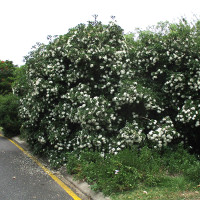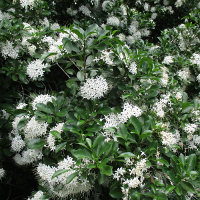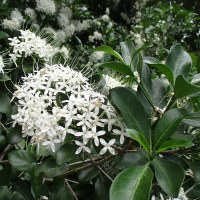
|
Information about plants & gardens for Brisbane & Qld |
|
|||
| |||
In some garden books, larger-growing herbaceous (i.e. non-woody) are grouped with the shrubs, but here "shrub" will be used to describe a plant with woody stem(s) that is bushy down to the ground.
Most shrubs as they're typically grown in gardens range from ground-hugging (prostrate) up to 2-3m. Some "shrub" species which can tend to climb or become trees if left to their own devices are kept smaller with regular cutting back.
Conversely, some shrubby plants can be trained as small trees with appropriate pruning. Select one or a few main stems to form the trunk(s) and progressively removing lower branches over time until the canopy reaches the desired height.
Shrubs are also the raw material for hedges and topiary, created by regular trimming.
On the other hand, by growing shrubby plants informally (i.e. in a more natural style) they won't need as much maintenance over the long term. They may still benefit from occasional pruning to keep them dense and train them within the desired height and width.
Shrubs can serve so many useful functions and tend to make up the bulk of most gardens, yet aren't as appreciated as they should be. Many of the best shrubs to grow in Brisbane and the subtropical regions of Australia are covered in Get Results Gardening. That's a weekly email publication for Australian gardeners, especially those in the warmer parts of the country. To learn how to get a free trial, go to calyx.com.au/getresultsgardening.html or simply click on the banner below ☟.
The following is not a complete list (it will be developed further over time), but here are some of the more popular types of shrubs used in Qld. Links go to a dedicated page on this website. For the sake of legibility on screen, botanical names in the list have not been italicised.
| A B C D E F G H I J K L M N O P Q R S T U V W X Y Z |
|
Acmena - see Lilipilly
Acokanthera
Austromyrtus - included on Lilipilly page
Bartlettina
Coprosma
Escallonia
Euonymus
Eupatorium - see Bartlettina
Hamelia patens
Iboza - see Tetradenia riparia
Ilex
Iochroma
Lagunaria
Mackaya
Pavetta
  
Pavetta capensis
Polygala
Randia
Reinwardtia
Rosa Roses
Tweedia (also known as Oxypetalum coeruleum)
Vitex
Waterhousia - see Lilipilly
|
Shrubs occur on 40% of Earth's land surface, making them more common than trees at 28%. Theoretical modelling has shown that it is the multistemmed nature of shrubs that makes then so successful. For a given volume of above-ground wood, the greater cross-sectional area at the base means water and nutrients can be transported faster to the leaves. The larger area of bark, from which buds sprout, is also believed to be advantageous because a canopy of twigs and leaves can be developed faster. Trees can ultimately attain the height that allow them to compete, but not before the faster shrubs have flowered and spread their seed. The growth form of shrubs are also better suited to extreme environments. Source: Shrubs More Expansive Than Trees (September 2016)
|
© Calyx Horticultural Services ABN 38 518 961 623
|